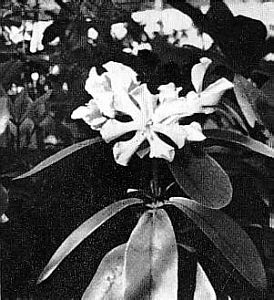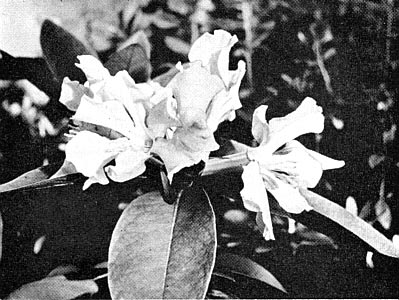QBARS - v20n2 Tropical Malaysian Rhododendrons in Boskoop
Tropical Malaysian Rhododendrons in Boskoop
Dipl. Ing. F. Schneider
"Sonderdruck Aus Dem Jahrbuch 1965 der Rhododendron-Gessellschcaft, Bremen"
Reprinted, with permission, from the Yearbook of the German Rhododendron Society
It is not well known among rhododendron breeders and hobbyists that this large plant family also has about 300 species in Malaysia, but readers of the German Rhododendron Yearbook have found information about the wealth of species in two articles by Professor Sleumer about his experience with rhododendrons in Malaysia and Thailand.
In these articles it is periodically spoken of the shipment of living plant material and seed to botanical gardens, nurseries and hobbyists. The nursery experimental station in Boskoop has received rhododendron seed since 1955 and rhododendron cuttings since 1960 from Borneo, the Philippines, Malaya and especially from New Guinea. In Boskoop we tried to find out in what way these wild species can be utilized in the enrichment of our plant material. We are not thinking of the introduction into the nursery industry but more of the possibilities of crossing special characteristics of these wild species into our already existing rhododendron assortment.
The nursery experimental station in Boskoop works together with the institution for breeding of garden plants in Wageningen, and is also, for that reason, interested in tropical Malaysian rhododendrons, which in several ways are different from rhododendrons we know from semi-tropical zones in Asia and America.
The blossoms of Malaysian rhododendron species are frequently bigger than those of Asian species, in which the length of the corollas does not go over 10 cm. (3.94 inches), and in their color scale appear intense red and especially orange and deep yellow tones, while the blues are missing. It may be mentioned that the cultivation of those wild species is also important for the taxonomist.
According to our experience it is better to grow from seeds than from cuttings. It is easier to send seeds, and it is possible to grow more plants which possibly may represent the full variation in one species, and of which some seedlings may adjust to the artificial climate in the greenhouse better than others. Unfortunately it is very difficult to get seed of epiphytic rhododendrons, which grow in the crowns of high tropical trees. It is easier to get seeds of shrubs in the undergrowth of the woods or in more or less open vegetation.
Cuttings, on the other hand, are very difficult to get in good quality, since, in the long journey they will get either too moist or too dry. The only advantage of cuttings is the fact that they are, from the physiological standpoint, older than seedlings and thus will arrive at a blooming stage earlier than seedlings, which have to go through a longer period.
Our experiments in trying to graft cuttings of Malaysian rhododendrons onto R. ponticum , all failed. In Boskoop the seeding is being done in clay pots, which are filled with earth from a Boskoop nursery and covered with a thin layer of peat moss. The seeds have to be cleaned of all impurities, which can easily cause mold; in case mold should occur anyway it has to be sprayed with T. M. T. D. at an early stage. These agents also prevent, to a large extent, an invasion of moss, and even very small seedlings can stand it. The clay bowls are set under glass in greenhouse beds. The seeds will germinate after about 3 to 6 weeks; if nothing happens by then, they can be discarded. The seedlings will then receive an additional amount of light with daylight lamps, which extend the day to 18 hours. The little plants will be transplanted about twice a year to acquire a good root system.
Cuttings are planted into small pots, which are filled with peat moss and set under glass in beds. As soon as roots develop the glass is removed. In the beginning we tried to get a good root system by constant fogging; the results were not as good.
The growth in a tropical greenhouse was very different for each species. Some were growing well; others suffered from lack of nutrition and (apparently secondarily occurring) fungus infections. In spite of this we still have 30 out of 46 species. Strangely enough, the rule for survival that we found was the larger the leaves the easier it was to keep the species alive. Of course there are exceptions, as for instance the small leaved originally epiphytic R. rarum , which is very easily propagated.
| Up till now six (6) species have bloomed in our greenhouse: | |
| R. zoelleri | R. bryophilum |
| R. macgregoriae | R. wrightianum var cyclopense |
| R. leptanthum | R. leucogigas |
| All these species come from New Guinea. | |
R. zoelleri (Fig 28) had corollas which were orange-yellow in the middle and deep orange red to the edge; both diameter and the length of the blossoms were about 8 cm (3.1 inches). In the wild specimens the corollas are usually even bigger. But it is known that under greenhouse conditions the normal size of the blossoms of wild specimens cannot be reached.

|

|
|
Fig. 28.
R. zoelleri
with two flower
trusses, corollas orange-yellow, length and diameter each about 8 cm. (3.1 in.) |
Fig. 29.
R. leucogigas
with flower bud
shortly before opening. Leaves up to 36 cm. (14.17 inches) long. |
Of
R. macgregoriae
two kinds flowered: one originally terrestrial kind with a yellow color and one originally epiphytic kind with a red color. Both kinds have flowered several times.
R. leptanthum
and
R. bryophilum
both showed some inconspicuous blossoms when the cuttings were hardly rooted. One cutting of
R. wrightianum
var.
cyclopense
had two flower trusses. The flowers were relatively small, cylindrical, and shiny carmine red. It is reported that cuttings of the same plant, which were propagated in San Francisco, have flowered there also. Unfortunately, our specimen did not survive the strain.

|

|
| Fig. 56. R. leucogigas in full bloom |
Fig. 57.
R. leucogigas
in full bloom, the corolla, which
consists of 7 parts has a total length of 14 cm. (5.51 inches). The length of the tubular part is about 8.5 cm. (3.35 inches). The section measured across the horizontally projecting petals, is about 12 cm. (4.72 inches). Corolla is white, flushed red along the tubular part, fading out into the petals. |
The flowering of R. leucogigas was an event. This bushy epiphyte was discovered by H. Sleumer in the year 1961 in the Cycloop Mountains on the northern coast of New Guinea at a height of about 1200 m. (3937 feet) above sea level. The description was based solely on the leaves, an immature flower bud and two unripe fruits. Cuttings went to Boskoop, San Francisco and Seattle. This species was observed in flower for the first time as a cultivated plant. The flower bud (see Fig. 29) was about 10 cm. (3.94 inches) long, before it opened; the bracts were shiny carmine red. The loose cluster of flowers had 8 blossoms with short stalks. The trumpet-shaped corollas were of fleshy substance, 14 cm. (5.51 inches) long, white, flushed red on the tubular part of the blossom and fading out into the petals. They possess a heavy Carnation fragrance, which was apparent upon entering the greenhouse. The wild specimen might have corollas from 16 to 20 cm. (6.30 to 7.87 inches) long, which would make it the species with the biggest blossoms of the rhododendron family.
To this time, all tropical Malaysian rhododendron have flowered in fall. We do not know to what extent this is accidental or connected with the temperature and length of the day. Unfortunately this blooming period is very inconvenient for testing the crossing possibilities with rhododendrons from moderate climates. There are only a few references in literature. Leach Rhododendrons of the World , p. 528 says, "that these tropical rhododendrons are reported to be difficult and perhaps impossible to cross with the familiar scaly leaved rhododendrons from more temperate climates." On the other hand, in the previous century, crosses of species and back crosses have combined apparently without difficulties up to five different Malaysian species in a complex hybrid. The hybrid 'Pearl' has been developed out of a cross between 'Princess Royal' ( R. jasminiflorum x R. javanicum ) with the scale-free R. griffithianum ( auklandii ) from the Himalaya (see Henslow, J. Hort. Soc. 13, 1891, 240-283, Fig. 1-44). Hence, we hope that eventually we will also be successful with crosses between the Malaysian greenhouse rhododendrons which are under cultivation and Asian or American greenhouse or outdoor rhododendrons.
Upon completion of this article in Feb./March 1965, the following rhododendrons were still blooming in Boskoop: R. aurigeranum (Jahrbuch 1963, p. 16, fig. 16) and R. laetum (Jahrbuch 1963, p. 28, fig. 35). The seed of R. laetum had been collected by H. Sleumer on the Anggi-Gita-Lake (Arfak mountains, N.N.W. New Guinea) at a height of 1840 m. (6036 feet), and it was sown by us in February 1962. In spite of the strong growth of the seedlings we had not expected the blossoms so soon. The corollas of R. laetum are wax-like; at the time of opening they were of clear, deep yellow color with a silk-like sheen, about 5.5 cm. (2.16 inches) long. Crosses between R. leucogigas x R. zoelleri and R. macgregoriae x R. zoelleri were successful. We already have some seedlings.
